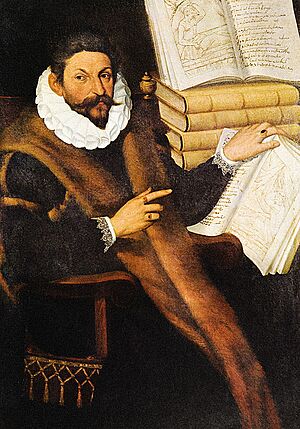Gaspare Tagliacozzi facts for kids
Gaspare Tagliacozzi (born in Bologna, Italy, in March 1545 – died in Bologna, 7 November 1599) was an Italian surgeon. He was a very important pioneer in the field of plastic and reconstructive surgery.
Contents
Early Life and Education
Gaspare Tagliacozzi was born in Bologna, Italy. He started studying medicine in 1565 at the University of Bologna.
He learned from famous teachers like Gerolamo Cardano (for medicine), Ulisse Aldrovandi (for natural sciences), and Julius Caesar Aranzi (for anatomy). When he was 24, he earned his degree in both philosophy and medicine.
Career and Contributions
After graduating, Tagliacozzi became a professor of surgery. Later, he also became a professor of anatomy. He taught at the Archiginnasio of Bologna, a famous university building. The room where he taught was rebuilt after being damaged in World War II. Today, it has a wooden statue of Tagliacozzi.
Even before he finished his studies, Tagliacozzi began working at the Hospital of Death in 1568. This hospital was like a teaching clinic for students.
Tagliacozzi greatly improved an old surgical method. This method was used for rebuilding noses. It was called the "Italian method." His most important book, De Curtorum Chirurgia per Insitionem (1597), describes this method in great detail. The title means "On the Surgery of Mutilation by Grafting."
This book helped him become known as one of the first plastic surgeons. A famous quote from his book shows his dedication: "We restore, rebuild, and make whole those parts which nature hath given, but which fortune has taken away. Not so much that it may delight the eye, but that it might buoy up the spirit, and help the mind of the afflicted." This quote means that his work was not just about making people look better. It was also about helping them feel better about themselves.
The Italian Method of Nose Reconstruction
Why the Method Was Needed
This special surgery for rebuilding noses, called rhinoplasty, became popular in Italy. This was because of the many duels fought with swords (like the rapier) in the 1400s, 1500s, and 1600s. These duels often caused severe injuries to people's faces, especially their noses.
How the Method Developed
The first surgeons to use this method were likely Gustavo Branca and his son Antonio. They lived in Catania around the 1400s. Gustavo Branca used skin from the cheek to rebuild a nose. Later, his son Antonio used a flap of skin from the arm.
Some historians think that ideas for reconstructive surgery came from an ancient Indian medical text called the Sushruta Samhita. This text was translated into Arabic in the 700s. These ideas might have then traveled to Italy.
Two brothers, Peter and Paul Boiano (also called Vianeo), continued this work in Calabria in the 1500s. Even the famous anatomist Andreas Vesalius (1514-1564) wrote about this process. However, he wrongly suggested using muscle and skin from the arm.
Another surgeon, Gabriele Fallopio (1523-1562), criticized the method. He pointed out that patients had to keep their arm still for many months. Also, the new skin did not always attach well. Tagliacozzi likely learned about the Boiano method from Leonardo Fioravanti.
Later Use and Rediscovery
Tagliacozzi's method was used by other surgeons like Fortunio Liceti and Henricus Moinichen. Thomas Feyens, who studied with Tagliacozzi, also wrote about it.
However, the use of this surgery slowly stopped in Europe during the 1600s. Tagliacozzi's method was almost forgotten. But in the 1800s, a German surgeon named Karl Ferdinand von Graefe rediscovered and started using it again. It was then used until the early 1900s.
Death
Gaspare Tagliacozzi died in Bologna on November 7, 1599. He was buried in a church, as he had asked in his will. A special ceremony was held for him later that month. Many doctors attended to honor him.


